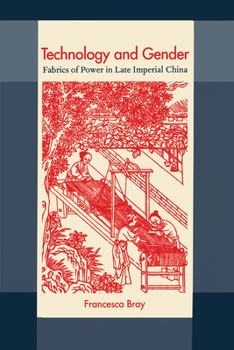Technology and Gender: Fabrics of Power in Late Imperial China
Select Format
Select Condition 
Book Overview
Exploring eight centuries of private life in China, anthropologist Francesca Bray counters Western perceptions of subservient Oriental women and reveals that female heirarchies within Chinese families reinforced the power of wives, whose responsibilities included ritual activities, financial management, and the education of children. Illus.
Format:Paperback
Language:English
ISBN:0520208617
ISBN13:9780520208612
Release Date:July 1997
Publisher:University of California Press
Length:444 Pages
Weight:0.05 lbs.
Dimensions:1.0" x 6.0" x 8.9"
Customer Reviews
1 rating
History As People Lived It, Not Just A Stage For The Elite
Published by Thriftbooks.com User , 24 years ago
Bray makes a great point in her introduction to this book that I believe sums up her work. She discusses the frustration of museum goers in seeing ancient tools and furniture but not being allowed to touch them. Contacting these domestic objects would connect us to ancient ways of life if only we could actually grab and hold them for a moment.This hits on the sort of history Bray is writing: she shows us what it was like to live in the period she discusses (1000-1800) by examining the then-current technology. This technology, really the techniques for ordering and creating existence, is broadly defined. She shows the techniques and rules in building a home and the spaces therein defined for women and men. She shows the advice, tools and explicit values put on the everyday chores of weaving, farming, childrearing that actually claimed the lives of people in those days (and today... with less farming and weaving and more office work). Her third section, which is filled with rich details but points to no obvious conclusion, focuses on gynotechnics, the process of making a woman. The medical, moral and economic thought of the day create an interesting complement and contrast to the drudgerous facts that she has made come alive earlier in the book in an oddly fascinating way.This is not an economic history like Wong or Pomeranz have recently produced. It is a Sinological micro-history while the latter two were comparative macro-histories. It is, however, wonderful. The details she finds in construction manuals, tools, even instructional pictures of looms give students like myself a way to tie the 'big picture' facts down to the human level details that we often don't even realize we've been missing until a book like this comes along.





